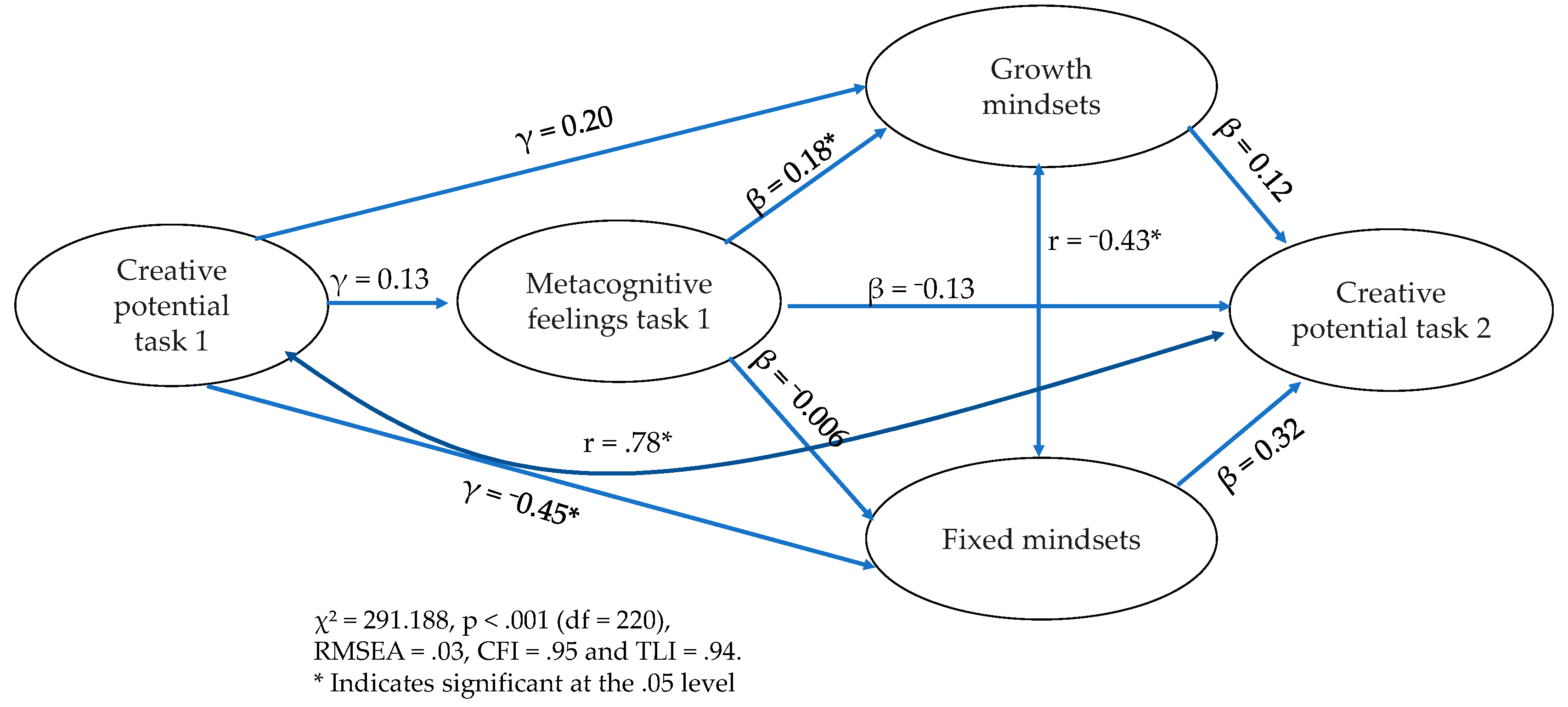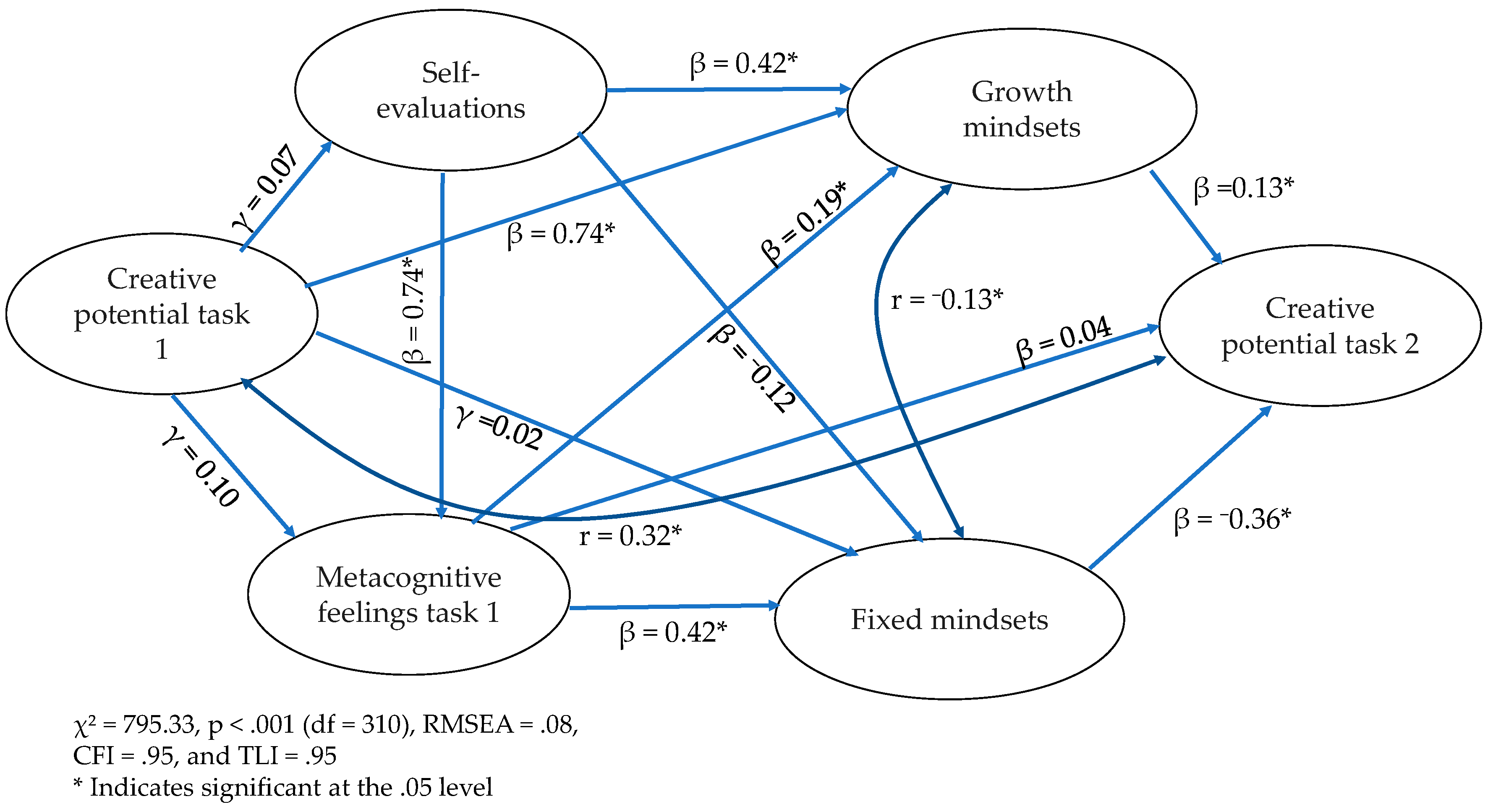Becoming Self-Aware of Feelings and Performance: The Influence of Creative Potential, Self-Evaluations, and Metacognitive Feelings on Creative Mindsets
Abstract
1. Introduction
1.1. Guiding Principles
1.2. Creative Metacognition
1.3. Creative Mindsets as Knowledge Structures
1.4. Overview of Studies
2. Study 1
2.1. Material and Method
2.1.1. Participants and Procedure
2.1.2. Measures
The company Apple is one of the most successful in the world. However, in the last quarter of 2018, Apple reported lower sales than expected, especially for its new iPhones: iPhone XS and XS Max. In addition, the forecasts for the first quarter of 2019 are not optimistic. We want you to think that Apple has just hired you as a consultant and your first task is to generate ideas to revert the decline in sales. What do you think it can be done? Your ideas could represent many things including product improvements, design, new colors, Apps, positioning, price, distribution, and advertising, among others. Generate three novel and useful ideas and write them in the space below please.
Mexico has a serious problem of frequent floods and the main causes of these floods are litter that covers the drains. The amount and variety of litter that is thrown away are significant, from food wrappers and containers to cigarette butts. We would like you to think that you have been just hired to act as a consultant and your first task is to generate ideas to create a campaign to reduce litter on the streets. What do you think it can be done? Generate three novel and useful ideas and write them in the space below please.
2.2. Results
2.2.1. Overview of Analytical Strategy
2.2.2. Structural Equation Model
2.3. Brief Discussion
3. Study 2
3.1. Material and Method
3.1.1. Participants and Procedure
3.1.2. Measures
Most of us are familiar with cell phones or smartphones. We are going to ask you to generate ideas to improve cell phones. The ideas have to be original (uncommon) and effective (solve a consumer problem). Generate three original and effective ideas and write them in the space below please.
Most of us are familiar with the company Apple. For this task, we are going to ask you to generate ideas to increase the number of subscriptions to its Apple TV+ service. The ideas have to be original (uncommon) and effective (solve a consumer problem). Generate three original and effective ideas and write them in the space below please.
3.2. Results
3.3. Brief Discussion
4. General Discussion
4.1. Creative Metacognition: The Role of Creative Mindsets
4.2. Limitations and Future Directions
4.3. Implications for Education
Author Contributions
Funding
Institutional Review Board Statement
Informed Consent Statement
Data Availability Statement
Conflicts of Interest
References
- Ackerman, Rakefet. 2019. Heuristic cues for meta-reasoning judgments: Review and methodology. Psychological Topics 28: 1–20. [Google Scholar] [CrossRef]
- Beaty, Roger E., and Paul J. Silvia. 2012. Why do ideas get more creative across time? An executive interpretation of the serial order effect in divergent thinking tasks. Psychology of Aesthetics, Creativity, and the Arts 6: 309–19. [Google Scholar] [CrossRef]
- Beghetto, Ronald A. 2021. My favorite failure: Using digital technology to facilitate creative learning and reconceptualize failure. TechTrends 65: 606–14. [Google Scholar] [CrossRef]
- Dweck, Carol S. 1999. Self-Theories: Their Role in Motivation, Personality and Development. Philadelphia: Taylor and Francis/Psychology Press. [Google Scholar]
- Firestein, Stuart. 2015. Failure: Why Science Is so Successful. New York: Oxford University Press. [Google Scholar]
- Hass, Richard W., Jen Katz-Buonincontro, and Roni Reiter-Palmon. 2019. The creative self and creative thinking: An exploration of predictive effects using Bayes factor analyses. Psychology of Aesthetics, Creativity, and the Arts 13: 375–87. [Google Scholar] [CrossRef]
- Karwowski, Maciej, Izabela Lebuda, and Ronald A. Beghetto. 2019a. Creative self-beliefs. In Cambridge Handbook of Creativity, 2nd ed. Edited by James C. Kaufman and Robert J. Sternberg. New York: Cambridge University Press. [Google Scholar]
- Karwowski, Maciej, Marta Czerwonka, Izabela Lebuda, Dorota Maria Jankowska, and Aleksandra Gajda. 2019b. Does thinking about Einstein make people entity theorists? Examining the malleability of creative mindsets. Psychology of Aesthetics, Creativity and the Arts 14: 361–66. [Google Scholar] [CrossRef]
- Karwowski, Maciej, Mi-Hyun Han, and Ronald A. Beghetto. 2019c. Toward dynamizing the measurement of creative confidence beliefs. Psychology of Aesthetics, Creativity, and the Arts 13: 193–202. [Google Scholar] [CrossRef]
- Karwowski, Maciej. 2014. Creative mindsets: Measurement, correlates, consequences. Psychology of Aesthetics, Creativity, and the Arts 8: 62–70. [Google Scholar] [CrossRef]
- Koriat, Asher, and Morris Goldsmith. 1996. Monitoring and control processes in the strategic regulation of memory accuracy. Psychological Review 103: 490–517. [Google Scholar] [CrossRef] [PubMed]
- Koriat, Asher. 2006. Are we frightened because we run away? Some evidence from metacognitive feelings. In Memory and Emotion: Interdisciplinary Perspectives. Edited by Bob Uttl, Nobuo Ohta and Amy L. Siegenthaler. Malden: Blackwell, pp. 83–103. [Google Scholar]
- Lebuda, Isabela, and Mathias Benedek. 2023. A Systematic Framework of Creative Metacognition. Available online: https://psyarxiv.com/s793q/ (accessed on 12 March 2023).
- Leith, Scott, Cindy Ward, Miranda Giacomin, Enoch Landau, Joyce Ehrlinger, and Anne E. Wilson. 2014. Changing theories of change: Strategic shifting in implicit theory endorsement. Journal of Personality and Social Psychology 107: 597–620. [Google Scholar] [CrossRef] [PubMed]
- Mrazek, Alissa J., Elliott D. Ihm, Daniel C. Molden, Michael D. Mrazek, Claire M. Zedelius, and Jonathan W. Schooler. 2018. Expanding minds: Growth mindsets of self-regulation and the influences on effort and perseverance. Journal of Experimental Social Psychology 79: 164–80. [Google Scholar] [CrossRef]
- Newen, Albert, Leon De Bruin, and Shaun Gallagher, eds. 2020. 4E cognition: Historical roots, key concepts, and central issues. In The Oxford Handbook of 4E Cognition. Oxford: Oxford University Press, pp. 3–18. [Google Scholar]
- Plaks, Jason E. 2017. Implicit theories: Assumptions that shape social and moral cognition. Advances in Experimental Social Psychology 56: 259–301. [Google Scholar] [CrossRef]
- Plaks, Jason E., and Kristin Stecher. 2007. Unexpected improvement, decline, and stasis: A prediction confidence perspective on achievement success and failure. Journal of Personality and Social Psychology 93: 667–84. [Google Scholar] [CrossRef] [PubMed]
- Puente-Díaz, Rogelio, and Judith Cavazos-Arroyo. 2020. Creative metacognitive feelings as a source of information for creative self-efficacy, creativity potential, intrapersonal idea selection, and task enjoyment. The Journal of Creative Behavior 54: 499–507. [Google Scholar] [CrossRef]
- Puente-Díaz, Rogelio, and Judith Cavazos-Arroyo. 2022. Creative self-efficacy and metacognitive feelings as sources of information when generating evaluating, and selecting creative ideas: A metacognitive perspective. The Journal of Creative Behavior 56: 647–58. [Google Scholar] [CrossRef]
- Puente-Díaz, Rogelio, Judith Cavazos-Arroyo, and Lizbeth Puerta-Sierra. 2021. Idea generation, selection and evaluation: A metacognitive approach. The Journal of Creative Behavior 55: 1015–27. [Google Scholar] [CrossRef]
- Puente-Díaz, Rogelio. 2023. Metacognitive feelings as a source of information for the creative process: A conceptual exploration. Journal of Intelligence 11: 49. [Google Scholar] [CrossRef] [PubMed]
- Royston, Ryan, and Roni Reiter-Palmon. 2019. Creative self-efficacy as mediator between creative mindsets and creative problem-solving. The Journal of Creative Behavior 53: 472–81. [Google Scholar] [CrossRef]
- Runco, Mark A., and Selcuk Acar. 2019. Divergent thinking. In The Cambridge Handbook of Creativity. Edited by James C. Kaufman and Robert J. Sternberg. New York: Cambridge University Press, pp. 224–54. [Google Scholar]
- Sidi, Yael, Ilan Torgovitsky, Daniela Soibelman, Ella Miron-Spektor, and Rakefet Ackerman. 2020. You may be more original than you think: Predictable biases in self-assessment of originality. Acta Psychologica 203: 103002. [Google Scholar] [CrossRef] [PubMed]
- West, Stephen G., Aaron B. Taylor, and Wei Wu. 2012. Model fit and model selection in structural equation modeling. In Handbook of Structural Equation Modeling. Edited by Rick H. Hoyle. New York: Guilford Press, pp. 209–31. [Google Scholar]


| Sequences | Divergent Thinking Task | Metacognitive Feelings | Self-Evaluations | Creative Mindsets | Second Divergent Thinking Task |
|---|---|---|---|---|---|
| Study 1 | First | Second | N/A | Third | Fourth |
| Study 2 | First | Second | Third | Fourth | Fifth |
| Study 1 | Coefficient | p-Value |
|---|---|---|
| Metacognitive feelings on creative potential task 1 | 0.13 | 0.28 |
| Growth mindset on creative potential task 1 | 0.2 | 0.21 |
| Fixed mindset on creative potential task 1 | −0.45 | <.001 |
| Growth mindset on metacognitive feelings | 0.18 | 0.01 |
| Fixed mindset on metacognitive feelings | −0.006 | 0.94 |
| Creative potential task 2 on growth mindset | 0.12 | 0.62 |
| Creative potential task 2 on fixed mindset | 0.32 | 0.41 |
| Creative potential task 2 on metacognitive feelings | −0.13 | 0.46 |
| Study 2 | ||
| Self-evaluations on creative potential task 1 | 0.07 | 0.23 |
| Metacognitive feelings on creative potential task 1 | 0.10 | 0.17 |
| Metacognitive feelings on self-evaluation | 0.74 | <.001 |
| Growth mindset on creative potential task 1 | 0.07 | 0.23 |
| Growth mindset on metacognitive feelings | 0.19 | 0.03 |
| Growth mindset on self-evaluations | 0.42 | <.001 |
| Fixed mindset on creative potential task 1 | 0.02 | 0.80 |
| Fixed mindset on metacognitive feelings | 0.42 | <.001 |
| Fixed mindset on self-evaluations | −0.12 | 0.30 |
| Creative potential task 2 on growth mindset | 0.13 | 0.22 |
| Creative potential task 2 on fixed mindset | −0.36 | <.001 |
| Creative potential task 2 on metacognitive feelings | 0.04 | 0.76 |
Disclaimer/Publisher’s Note: The statements, opinions and data contained in all publications are solely those of the individual author(s) and contributor(s) and not of MDPI and/or the editor(s). MDPI and/or the editor(s) disclaim responsibility for any injury to people or property resulting from any ideas, methods, instructions or products referred to in the content. |
© 2023 by the authors. Licensee MDPI, Basel, Switzerland. This article is an open access article distributed under the terms and conditions of the Creative Commons Attribution (CC BY) license (https://creativecommons.org/licenses/by/4.0/).
Share and Cite
Puente-Díaz, R.; Cavazos-Arroyo, J.; Puerta-Sierra, L. Becoming Self-Aware of Feelings and Performance: The Influence of Creative Potential, Self-Evaluations, and Metacognitive Feelings on Creative Mindsets. J. Intell. 2023, 11, 138. https://doi.org/10.3390/jintelligence11070138
Puente-Díaz R, Cavazos-Arroyo J, Puerta-Sierra L. Becoming Self-Aware of Feelings and Performance: The Influence of Creative Potential, Self-Evaluations, and Metacognitive Feelings on Creative Mindsets. Journal of Intelligence. 2023; 11(7):138. https://doi.org/10.3390/jintelligence11070138
Chicago/Turabian StylePuente-Díaz, Rogelio, Judith Cavazos-Arroyo, and Lizbeth Puerta-Sierra. 2023. "Becoming Self-Aware of Feelings and Performance: The Influence of Creative Potential, Self-Evaluations, and Metacognitive Feelings on Creative Mindsets" Journal of Intelligence 11, no. 7: 138. https://doi.org/10.3390/jintelligence11070138
APA StylePuente-Díaz, R., Cavazos-Arroyo, J., & Puerta-Sierra, L. (2023). Becoming Self-Aware of Feelings and Performance: The Influence of Creative Potential, Self-Evaluations, and Metacognitive Feelings on Creative Mindsets. Journal of Intelligence, 11(7), 138. https://doi.org/10.3390/jintelligence11070138






